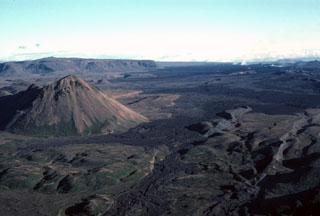Report on Krafla (Iceland) — October 1978
Scientific Event Alert Network Bulletin, vol. 3, no. 10 (October 1978)
Managing Editor: David Squires.
Krafla (Iceland) Slow inflation continues; center of uplift higher than levels which triggered earlier deflations
Please cite this report as:
Global Volcanism Program, 1978. Report on Krafla (Iceland) (Squires, D., ed.). Scientific Event Alert Network Bulletin, 3:10. Smithsonian Institution. https://doi.org/10.5479/si.GVP.SEAN197810-373080
Krafla
Iceland
65.715°N, 16.728°W; summit elev. 800 m
All times are local (unless otherwise noted)
"Inflation in the Krafla caldera continues at a somewhat reduced rate. The land height at the center of the uplift is now higher than at any time previously and deflation is expected within the next few weeks. A geologist is now permanently positioned in the area to advise the Civil Defense authorities. The seismometers and the continuously recording tiltmeters are now watched hourly day and night."
Geological Summary. The Krafla volcanic system in the Northern Volcanic Zone (NVZ) of Iceland is about 100 km long, consisting of a fissure swarm and a central volcano with a 7 x 9 km caldera formed about 110,000 years ago that deposited a rhyolitic welded tuff. It has been moderately active in the Holocene, over three distinct eruptive periods; the current one has lasted about 2,800 years with six volcano-tectonic episodes, each with one or more basaltic fissure eruptions. Lava volumes (DRE) have been in the 0.1-1 km3 range. The Hverfjall and Ludent tuff rings east of Myvatn were erupted along the fissure system. Myvatn lake formed during the eruption of the older Laxarhraun lava flow from the Ketildyngja shield volcano of the Fremrinamur volcanic system about 3,800 years before present (BP); The present Myvatn lake is constrained by the roughly 2,000 years BP younger Laxarhraun lava flow from the Krafla volcanic system. The abundant pseudocraters that form a prominent part of the Myvatn landscape were created when the younger Laxarhraun lava flow entered the lake. The last eruption took place in 1975-1984 CE when nine small basaltic fissure eruptions produced 0.25 km3 of lava.
Information Contacts: K. Grönvold, NVI.

